By Jackie Clay-Atkinson
I’ve written a lot about food storage for a preparedness pantry in the past. Much of it is now found in the book Emergency Preparedness and Survival Guide (available on Kindle here) along with other authors’ valuable information. Of course, food and water are the first things that come to mind when folks begin thinking about how to survive in an emergency. However, there are a lot of other items people might forget about.
General food storage tips
First and foremost, it takes more food stored in your pantry than you would think to survive on — especially when you cannot go to the store to supplement it. When my youngest son was a baby, we lived way up in the mountains in Montana, seven miles from a road. At 7,400 feet in elevation, we were snowed in from December until mid-May. We could snowmobile down the mountain to get to our mailbox, and from there drive to the store for any lightweight essentials, but because of the rugged terrain and snowdrifts, we could not pack heavy items onto the snowmobile for the return trip, like gas for the generator, feed for the animals, flour, dog food, most groceries, lantern fuel, etc.
Because we couldn’t replenish our supplies, we used what we had, pretty much exclusively, for six months out of the year. I was amazed how much flour and cornmeal we used when baking all of our own baked goods. After the first year, storing 300 pounds of flour, plus additional wheat kernels, didn’t seem so excessive after all.
A simple way of calculating your needs is to add up what you use in one week and multiply it by 52 (for the weeks in a year). Remember that you won’t be buying bread, cookies, etc., and must consider that amount of flour and other dry goods in your figuring (for instance, there are 6-8 cups of flour in two loaves of bread).
Be sure you have a wide variety of foods stored; life gets pretty tedious when you just eat beans, rice, lentils, and wheat. I have a huge variety of foods stored up and I can continue cooking just as I do right now, right out of my pantry and garden. Store what your family likes, but also introduce some long-term storage foods into your family’s diet before you need to use them.
Always include such things as oils, shortening, spices, and even a few “treats” such as Jell-O, cake mixes (a good base for many desserts and they’re cheap), summer sausage (will keep more than a year, kept cool, without refrigeration), cans of ground or instant coffee, Tang (good source of Vitamin C and it masks the taste of filtered water), and any other family favorites that will store well.
Don’t forget to keep powdered items like milk, butter, shortening, and cheese, along with yeast, baking powder, and baking soda on hand. These are indispensable necessities when you’re trying to live out of your pantry.
Safe & secure food storage
Be sure your food is stored in safe containers. If you have a rodent problem, be sure the pests can’t get at your food. Storing food in heavy plastic pails with gasketed lids will usually protect it from rodents. But chipmunks and squirrels can chew through these buckets. If these critters are around your food storage spot, be sure to store your food in galvanized garbage cans or 55-gallon steel drums with tight-fitting lids. I’ve had squirrels chew holes in the tops of plastic garbage cans to get at the livestock feed inside. You can use gallon-size glass jars or smaller ones to store dehydrated foods, herbs, spices, etc.
I pick up my five-gallon food storage buckets from our local Super One market. Their bakery gets icing in them and once used and washed, they sell them for $1.50 each, including a gasketed lid. That’s a good buy. I use them to store beans, bags of brown sugar, rice, split peas, wheat, chocolate chips, and other dry foods.
I store popcorn in large galvanized garbage cans (I use it to grind for cornmeal if my garden corn did not mature that year, as well as eating as popcorn), sugar in the bags it came in, wheat, bags of store-bought cornmeal (it stores longer than freshly-ground cornmeal), masa harina (corn flour), bags of bulk noodles, and macaroni.
The bulk of our food is stored in our basement, where we do not have a rodent problem. An occasional house mouse is quickly trapped in one of the snap-traps that are always baited and laid out, just in case. I’ve never had a rodent problem in my pantry.
But years ago, in our remote Montana cabin, one season we did have a mouse invasion. They showed me that I couldn’t just store bags of food on our pantry shelves! Those mice quickly ate into and ruined many pounds of good food. (They not only eat it, but they poop in it too!) I learned my lesson, and now I use popcorn tins for all of the dry foods in my kitchen. These tins also keep other vermin, such as pantry moths, out of my food.
Consider dampness or flooding when you ramp up your emergency pantry. If you are in a flood-prone area, hurricane path, or place where low ground is the norm, be sure your pantry is wet-proof or be absolutely sure your food is stored in waterproof containers. Wet food is usually ruined food.
If your plan for emergency or long-term economic troubles is to move from your city home to a survival retreat, try to avoid storing your foods in glass containers. Glass jars may break during transportation. In an emergency, you won’t have much time. You might be able to get your home-canned foods packed, but if your dry goods are in resilient buckets, barrels, and other containers, you can pack up much quicker. A moving dolly is a great help when packing up barrels and garbage cans full of food. You get the job done quickly without back strain.
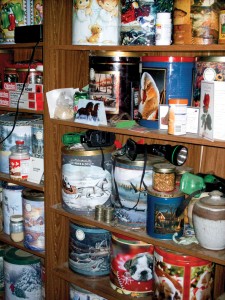
My kitchen pantry is full of popcorn tins filled with dry foods. Notice our rechargeable flashlights, ready at hand for instant use. The batteries sit in the charger until needed.
Garden seeds
While storing up food, consider how you will replace it when it’s gone. Too often, folks store up plenty of food with no idea of where more will come from. You don’t need canned “emergency” seeds, but you definitely do need a complete supply of open-pollinated garden seeds stored in an airtight, rodent/insect-proof container, kept in a cool, dark place. Each year, replace onion and parsnip seeds, which do not remain viable for as long as most other seeds do. Then in three years use the stored seeds and replace them with fresh ones. That way, you will not only have seeds for a garden, from which to eat and store up food for winter, but you can save your own seeds to replace those, if necessary, completing the circle.
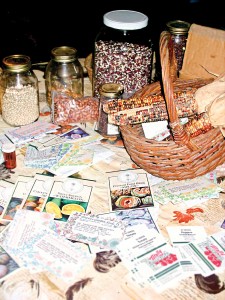
A good supply (and inventory) of open-pollinated garden seeds can feed your family in hard times; don’t be without them! Grandma said that during the Depression she couldn’t buy some garden seeds.
Canning supplies
Remember to stock up on canning jars and plenty of lids. I highly recommend buying several dozen (or more) reusable Tattler canning lids and rubbers. Although they are more expensive up front, you can safely reuse them time and time again. If you don’t already have a pressure canner, by all means buy one! With a pressure canner, you can safely home-can nearly all of your own foods, including meat, poultry, and fish. Lacking a water bath canner, you can use your pressure canner bottom as a boiling water bath canner with a loose fitting lid on top (no pressure).
Cheese cultures
If you have dairy animals, such as goats or a milk cow, store up rennet and cheese cultures. Cheese and other dairy products are easy to make at home, but they do require these starters. With the culture, you can easily re-culture your own milk, much as sourdough starter is kept going indefinitely. That way, come what may, you’ll always have cheeses, yogurt, sour cream, and other dairy products.
Bread yeast
In the same vein, don’t forget to include a pound of bulk yeast. I keep two; one in my freezer and one in the fridge. The frozen yeast stores for at least two years while I use the refrigerated yeast daily. You can also create a sourdough starter, and from it you can bake bread for years.
Cash
Try to have some cash on hand; more than you would usually have. Just in case. Checks and credit cards are no good if the economy suddenly tanks. Your money and your credit are gone! Buy and store at least some “junk” silver coins to use, should the economy really flounder.
Proper planning
Much emergency preparedness planning consists of figuring out how your family will handle various situations: how to cook, how to heat, how to go to the bathroom, how to get water, how to create lighting, how to take care of illnesses, how to take care of an elderly member of the family, a member with health concerns, a baby, a pet, livestock; how to protect them all from those who would steal what you have. What tools will you need? How will you store fuel for the vehicle, chainsaw, or generator? Will you stay put or evacuate (and to where)? A lot rides on your answers to these questions — perhaps your very life, but your comfort, at the very least.
How to cook
We have a propane stove with a pilot light and a 1,000-gallon tank outside that we try to keep pretty full. I also have a wood-burning cookstove in the kitchen, which I cook on all winter. It also helps heat the house.
If you have an electric stove or natural gas, you need another way to cook your food in an emergency. For less than $50, you can buy a two-burner countertop propane stove from outlets such as Northern Tool and Harbor Freight. They are sturdier than a Coleman camp stove and just as easy to haul around. You can even use a canner on one. You can buy 20- and 30-pound propane tanks at most stores that sell barbecues. A simple hose with small regulator, just like you use for a barbecue grill, is all you need to put you in business.
Another cooking option is using a charcoal barbecue grill to cook on, but this only works when the weather is nice enough to use outside. Charcoal grills are unsafe to use indoors.
Heat
We heat with wood, but we have a propane wall heater for backup. We use the propane if we have to be away from home at night in the winter or on extremely cold nights, to supplement our wood stove.
Everyone should have some type of alternative heat available. Most furnaces won’t work without electricity to run the blower. Without heat, the water pipes in the basement or crawl space will freeze and rupture and your toilet won’t flush (it might even crack and when the power does come on, you’ll still be in deep doodoo).
If you are able to have a wood stove, install one before you need it. Even if you have to buy a cord of wood to have on hand, it sure beats freezing in an emergency. There’s always a source of wood around: used pallets from lumber yards, wind-downed trees, and old buildings. (Years ago, I kept the house from freezing by going ¼ mile down the road to a fallen down barn on our property with a wheelbarrow and breaking up barn wood to bring home to burn.)
If you plan on heating with wood, stockpile enough dry, seasoned firewood to last at least one winter. This should be split into convenient pieces and stored in a covered location to protect it from getting wet. Wet wood does not provide the BTUs that dry wood does.
If you can’t afford to install a wood stove, or your insurance won’t let you, at least install a small propane heater or have a portable propane heater, such as the Big Heater Buddy (approved for indoor use) available. This may (or may not if you live in a cold climate) keep your house and you from freezing. Of course, a larger, installed propane heater will do both! If you don’t intend to heat with propane, you can use a 100-pound portable tank. Be sure to install your propane heater safely, venting it to the outside to protect your family from carbon monoxide poisoning.
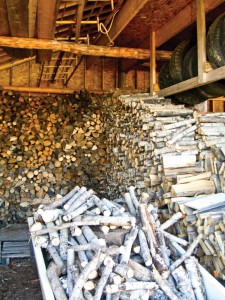
We heat and cook with wood in the winter. And we try to have at least two years’ worth of dry wood stockpiled at all times; we’ll always be warm and have a way to cook food.
Water
On our previous homesteads in Montana, our water came from springs, plumbed to our home via a storage tank. No electricity was required. Now we have a deep well with a submersible pump, which does require electricity. We have two 300-gallon poly tanks in our basement. When we start the generator, we turn the well switch on. When the valve in the basement is open, the tanks automatically begin to fill. We usually leave them partially open so when we water the livestock, the basement also gets a delivery of fresh water. It takes half an hour to fill both tanks if there isn’t any other water being diverted from the water line. While the water is filling, I usually make use of the generator to wash clothes. I get more bang for my buck by using the generator for multiple uses instead of just using it to power the well.
If gasoline became unavailable, we could use the spring below our house for water. The well is handier than the spring, but in case of an emergency we will always have water.
Storing several jugs of water is a great idea for the temporary storage pantry, but if the “emergency” becomes long-term you’ll need other options. Do you have a way of obtaining water without electricity? Or by use of a minimally-used generator? How about installing a water storage tank in your basement or burying it on a hillside above your house? You can buy a new poly water tank from most farm and ranch stores for about $1 a gallon. A few gallons of water is quickly used up, but a 300- or 400-gallon tank will buy you much more security. Keep it full, draining and re-filling it every few months. If you choose to bury a tank on a hillside above your house, you can plumb it to your home’s water system, where it can gravity feed into your water lines, giving you water pressure. But remember, with water pressure you will use more water.
Do you have a way of refilling your water supply once your storage water is gone? Without electricity, municipal water is usually quickly a thing of the past. Do you have a well? A generator will run a well pump. Or you can buy a hand pump, such as the Bison pump, which you can install in your well casing, beside your electric water pump.
Do you have a nearby stream, river, or lake? With the aid of a simple water purifier, such as one of the smaller Berkey units or the even smaller Katadyn filter, you can have potable water from these sources without worrying about bacterial or protozoan diseases such as giardia. Lacking these purifiers, you can always run the water through a clean cloth filter and boil it for drinking and washing dishes.
Be sure you have a way to carry water. You don’t want to lose water by splashing when you carry it, so those food-grade five-gallon buckets with gasketed lids are indispensable.
Bathroom
When we are used to a flush toilet in the bathroom, suddenly having no electricity creates havoc. No running water and no flush! The easiest temporary fix is to carry water in from a stream, lake, swamp, or even a ditch. Then use conservation methods; when you pee, leave it and toss the toilet paper in a trash can. When you need to flush, carry a bucket of water to refill the toilet tank.
But this is just a temporary solution, useful only if there is outside water available. It would be foolish to use your storage water for toilet flushing. A better method is to have an outhouse. In the city you can’t have one, right? Just dig a relatively deep hole in the back of your yard, out of the neighbors’ sight, then build a cute garden shed over it. Don’t use it for you-know-what until you need an outhouse. Be discreet; don’t blab around what you’ve done.
Another option is to use a “quickie” composting toilet. Again, those five-gallon buckets come to the rescue; one can’t have too many! Have a bale of wood shavings on hand. Use one bucket to urinate in, the other to do the other thing. With six inches of shavings in the bottom, and a handful tossed on top when you’re finished, there is no odor. A toilet seat on top helps things out. When it gets too full, take the bucket outside and dump it in a hole, in a discreet location. Tell the nosy neighbor you’re mulching your flowers! Or you can use a plastic garbage bag tucked into the bucket before use. Just tie it shut and take it outdoors for future disposal. Don’t put toilet paper into your composting bucket toilet; put it into a bag to burn outside or in your wood stove.
Of course, if you live in the backwoods, an outhouse is always a good idea! We’ve had several. Right now we have a septic system and plenty of water to flush with.
Lighting
There are a lot of options for creating lighting. Of course, one can always use a generator. There are many available: diesel, propane, and gas-fired units. All have their good and bad points. We have several portable gas generators. The best has a Honda engine, which has required very little service in the several years we’ve had it. Our next will be a propane generator so we can make use of our 1,000-gallon propane tank and the cheaper price of propane compared to gasoline. But you just can’t run a generator 24/7. Even in good times, this is not economically feasible. It costs an arm and a leg, not to mention wear and tear on the generator.
We have a battery backup, using six 6-volt golf cart batteries, along with a cheap 1,500-watt inverter. With this, our 12-volt water pump on our water system gives us constant water pressure, lights, and other power on demand, night and day. Of course, we are very energy conscious. Every light in the house is a CFL. We have the computer and television/DVD player on a surge protector strip with a switch on it. When we are finished, the switch is automatically snapped off so there are no phantom loads from appliances that are on when they are turned off. Our refrigerator is propane, as is my dryer (used on rainy days or when I’m in a hurry). We also have two small solar panels, with three more yet to be installed. We will be adding more, along with a wind charger, when finances allow.
A good option for emergency electricity is a small generator with at least one deep cycle (trolling motor) battery and a small inverter hooked to it. That way, you can hook a small battery charger to the battery, the inverter hooked to that, and you’ll have minimal electricity without having to run the generator. Friends of ours did this at their remote cabin and could power a small CFL light, a radio, and a VCR movie without running the generator. With less use, that battery will remain charged for several days.
Of course, kerosene and Coleman-type lamps are also viable methods of lighting. We’ve used them both. Kerosene burns cheaper but doesn’t put out as much light as a Coleman. We used to keep a 55-gallon drum of kerosene on a rack, next to a 55-gallon drum of gasoline for the generator on our remote Montana homestead. Both lay on their sides in cradles, with a faucet on the lower opening so we could access both fuels easily. In a little more than a year, we’d use up that 55 gallons of kerosene, bought at a bulk fuel dealer in town. Your gas will stay good much longer if you add a fuel stabilizer. Lamp oil will gum up your lamp wicks when you use the lamps frequently; use kerosene instead.
Candles are another alternative, but they produce little light and can be dangerous if left unattended or if you have small children.
Several good-quality flashlights in the home and vehicle are a must. The ones with LED lights produce more light with less battery use. I have a rechargeable spotlight/flashlight (under $20 at Northern Tool) that I find very useful. It shines brightly at a great distance and quickly recharges from our battery bank/plug-in. I can chase a bear away from the chicken coop, find escaped livestock, or check outdoor buildings and actually see what I’m doing!
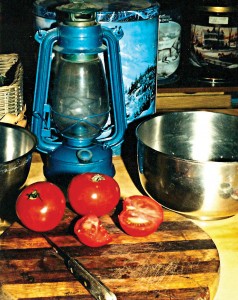
Emergency lighting is a must. Be sure to have good flashlights (and fresh batteries), kerosene lanterns, or other emergency lighting on hand, as well as fuel for them.
Medical
Always build a large medical kit. I use a large shooter’s box, similar to a tackle box, to hold most of our medical supplies. As I have extensive medical (veterinary) experience, I have included such things as an IV set, electrolytes, etc. that many other would not include. Again, check out Emergency Preparedness and Survival Guide for ideas on putting a medical kit together. Items that many people forget are cold, sore throat, allergy, and burn remedies; along with medications for fungal and yeast infections, anti-diarrheals, gas, and toothaches.
Ramp up that medical kit and put in a good first aid book so you know how to use it. I have our medical kit right in the bathroom, but it’s portable. When we travel, I can throw it in the back of the car and we’re always prepared.
I cared for my elderly parents until their deaths, so I was always conscious of their health needs, especially if an emergency came up. I slowly stockpiled their needed medicines (heart, blood pressure, etc.) by refilling each prescription just a little before I needed to. In that way, each month, I was able to put aside five or so of each pill “just in case.” Five pills every month for 12 months equals 60 pills — pills that they wouldn’t have had, otherwise! That could make the difference between life and death in some instances. Then, like food, I rotated the “old” pills, using them and replacing them with new ones. Luckily, we never needed them. But after several years, I had a lot on hand, which would have saved their lives, if needed.
I do this with my own blood pressure pills. It’s a provident idea for anyone using prescription drugs. Ask your doctor if they will prescribe a three- or six-month supply and try to find a pharmacist that will fill it.
Likewise, if you have any medical condition that chronically pops up, be sure you have medication to handle it. Will is severely allergic to bee stings. Not only do we have three Epi-Pens on hand, but we also have a vial of injectable epinephrine to counteract his allergic reactions.
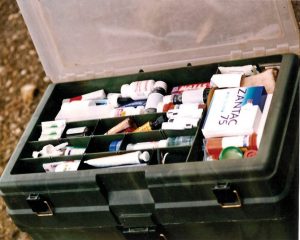
Here’s our medical kit. It contains a wealth of emergency medical supplies and medicine. Your “emergency” can be as small as mine yesterday — I cut my finger pretty deeply while pulling ferns from our electric fence.
Baby
Just like the elderly and those with medical needs, you need to prepare emergency needs for a baby in your family. Stockpile cloth and disposable diapers a size or two larger than your baby needs. Larger diapers are more adaptable than smaller ones. Formula, medications (teething, fever, diarrhea), cornstarch for diaper rash, warm blankets, and clothing should also be available, in case evacuation is necessary. Remember that infants are much more resilient than supposed. You really don’t need to stockpile tons of jars of baby food. They can eat simple, mashed “adult” food such as squash, noodles in broth, cooked cereals, carrots, potatoes, etc. After all, what did our grandparents do when they were babies and there were no canned baby foods?
If you might be using cloth diapers (and I did, by choice), be sure to have a couple of handy-dandy five-gallon buckets. I used to rinse the diapers in one bucket, then heat water on the stove and add the rinsed diapers, very hot water, and soap to another bucket. I’d slosh them around for a while with a stick, then rinse them in very hot water. By the time I put them in my wringer washer, they’d be about clean.
Pets
Be sure to provide for your livestock and pets when you are stocking up your storage pantry. Most dogs and cats will do very well on a good-quality dry food. I buy my dog food in 44-pound bags. You can cram several of these bags in a 55-gallon drum and it will stay good for more than a year. Like human food, protect pet food from dampness, rodents, and other varmints. Bears love dry dog food! While dogs and cats like canned foods, they will survive very well on dry food. If you want to stock up on some canned foods, do so. It will be a special treat for them. It’s also a good idea to stock up on such things as flea and tick spray, shampoo, Frontline-type products, ear mite remedies, fungus shampoos, etc.
Livestock
Be sure you have provisions for your livestock and poultry. Always be on the lookout for more pasture to add to your place, or rotate the grazing on the pastures you do have. A solar electric fence lets you rotate your livestock pasture and gain the most use and feed from that chunk of land. We recently bought the adjoining 40 acres to our place so we would always have plenty of pasture for our livestock. Will has been working hard on the fencing and hopefully, in a few weeks, we should have our stock on it, happily harvesting tons of feed.
We also acquired, by barter, a neighbor’s hayfield to cut hay on. Slowly, we’ve been adding haying equipment to our homestead so we can keep our storage building and new barn loft full of hay year-round. In addition, we buy 1,500 pound round bales from another neighbor and try to have plenty on hand … just in case.
If kept dry, square bales are good for years. Even big round bales, kept off of the ground on old pallets, are good for more than one year — often two or even three. True, you do lose the weathered “cap” and some food value, but it’s better than having your animals starve to death.
We try to have enough grain on hand to last awhile. Due to rising grain prices, we’re buying in bulk when we can, to not only save money but to have plenty on hand. In our new barn, we’re building a large, concrete-floored grain bin so we can get delivery by the bulk truck, right in the barn. That way we’ll be more secure.
Try to have as much grain and feed on hand as you can reasonably store without having moisture or rodent damage. Stored in 55-gallon drums, an old chest freezer, or galvanized garbage cans with lids, grain will remain great for months or even years. Don’t forget to stock up on such things as salt blocks, livestock wormers, and other medications. In my fridge I always have a vial of injectible medication for horse colic, and penicillin for pneumonia, mastitis, and other infections on hand for my livestock.

This is Lace, our milking shorthorn cow, who provides us with milk, butter, cheeses, sour cream, and more. Will and I bought her when we got married.
Personal protection
Personal protection and weapons for food procurement are also a necessity. One of the best forms of personal protection is living where you probably won’t need it! We live three hours north of the largest urban area, in a remote, off-the-beaten-path location, separated from the road by 1.3 miles of dirt trail. We have large dogs, weapons, and the experience to use them. Do you? Again, check out the information in the Emergency Preparedness and Survival Guide for gun-related tips and hints. They may save your life or the life of one of your family members. Be sure you have adequate ammunition for each of your guns on hand, stored in airtight, waterproof containers. Damp ammunition or the wrong ammunition is dangerous — it’s worse than no ammunition!
Don’t brag around how much “stuff” you have. It’s like an invitation for an attempted robbery.
Tools
Like guns, it’s a prudent idea to have the tools you will need to maintain a comfortable lifestyle handy, no matter what emergency situation arises. For instance, if you heat with wood, be sure to have at least a couple of gallons of chainsaw mix and bar oil on hand. It’s amazing how much firewood you can cut with those two gallons! Of course, more gas and two-cycle oil is always a plus, not only for cutting firewood but also for building projects and clearing downed trees from your yard and land. A few good chainsaw files for your chain will help keep your saw in good working order. You do know how to sharpen that saw, don’t you? You don’t need a huge saw. A smaller saw of a good brand, such as Stihl, works well for most homestead uses, and certainly for emergency needs.
Gardening equipment and supplies are extremely important. Have a good working tiller, shovel, and hoe, at bare minimum.
Have common tools in a stout tool box: at least a couple of crescent wrenches, pliers, screwdrivers (flat-tipped and Phillips), wire cutters, a crowbar, hammer, and hand saw. A good axe and sharp hatchet will make many chores, including butchering game, much easier. With these tools you should be able to handle most jobs.
Have kitchen tools, as well. They’re perhaps not what you’re used to using (unless you live like we do), but they’ll perform well when times are tough. One of these is a hand grain mill. Mine cost less than $50, on sale through Emergency Essentials, and is a Back to Basics brand. It grinds wheat very well, though it does take two passes to make fine flour. But it was cheap and does the job. Of course, a larger, more expensive mill will work faster and produce more acceptable flour with less work, if you have the cash. Another essential is a nest of stacking stainless steel stock pots with lids. Mine was also cheap, through Harbor Freight, and I have used them almost daily for years with nary a ding. I use them for cooking, canning, and food preparation. You might need to use them for heating water, as well.
Have a good pocket knife in your pocket at all times (everyone in our family carries one) and a lighter, as well. And have a couple of quality kitchen knives and a pack of a dozen lighters in your kitchen gear, as well. Add a sharpening stone, a little dry tinder (just in case), and your kit is in good shape!
Some miscellaneous equipment that is very valuable includes a child’s plastic toboggan (to drag wood, water, packs, and deer carcasses), a fire starter (magnesium/flint & steel), good backpacks for each member of the family full of 72-hour emergency supplies in case someone gets separated, a lightweight tent large enough to temporarily house the family, including a 10×10-foot tarp and a roll of ¼-inch nylon cord; a good compass and map. Have at least one working cell phone and the means to charge it. We have a crank-solar radio that not only gets shortwave, local, and weather channels, but charges our cell phones as well. Communication is very necessary in any kind of emergency, and it’ll be good to hear what’s going on in the world outside our backwoods nest.
Paper products you can replace with cloth
Don’t forget to include a good supply of feminine hygiene products. You can replace them with pads made from recycled used cloth, but a few bags of feminine products will be highly appreciated!
Forget Kleenex; you can use plain old handkerchiefs. Use, wash, and re-use. Paper towels? I just use old towels, cut into quarters. I use them, wash them, then re-use them. A really nasty job? Just use a nearly-worn-out piece, then toss it into the fire.
Evacuation plans
Do you live in a big city, where self-reliant living is very difficult without electricity and money? Do you live in a tsunami- or earthquake-prone area? How about forest fire danger? Do you live near any nuclear plant, military installation, or large city where a terrorist strike could necessitate evacuation? If so, decide ahead of time where you would go and how you would get there. Don’t wait until hundreds or even thousands of people will be thronging the streets, blocking your escape. Make your plans and if things are looking grim, decide to fill the car with gas, fill up some extra cans, pack up quickly, and evacuate before the crowds try to leave. You can always turn around and come back if the emergency was just a scare.
If you are planning on going to a friend or relative’s rural or remote home, ask in advance if you will be welcome. This is more than a simple courtesy; some folks only have room, facilities, and food enough for their own family! If six other family members show up, unannounced, it can severely impact the rural family. Don’t be the grasshopper from “The Ant and the Grasshopper” fable!
Instead, how about talking to that rural friend or family member ahead of time and offer to help out on the place, gardening, working with livestock (fencing, haying, etc.), helping stock up extra supplies and food for emergencies. In that way, you’ll be assured of a welcome and not being a hanger-on, riding the coattails of more provident people. You may need to remain with these people for a while!
Please don’t fall into the common myth that you’ll just head for the woods and “live off the land.” Sorry folks; ain’t gonna happen. It takes years of experience to live self-subsistently, even when times are normal. If the *%# hits the fan, game is going to be scarce in most areas; it’s going to be quickly shot off, just like it was in the old homesteading/pioneer days. And berries, wild plants, and nuts take a lot of gathering for you and your family survive. True, you can always fish and hunt. But don’t count on your family’s existence on these wild foods entirely unless you are very experienced and are living in a true wilderness area such as central Alaska.
Likewise, don’t just buy some canned “emergency” garden seeds and figure you’ll just dig up a garden and eat off that food. If you’ve never gardened, you won’t succeed in raising all your food the first year. Trust me here. Different families will have different plans and needs.
This is not a comprehensive list, but a few ideas and hints to help you think and plan as you build up your own preparedness pantry, supplies, and needs. I’m sure you can all add to my basic list with your own ideas. True, a human can be self-reliant with a knife, axe, and fire starter if they’re experienced and can handle hunger and privation. Even the most experienced woodsman, living entirely off the land, will be cold, hungry, and miserable at times. It’s nicer, by far, to have a ready supply of food, tools, and most important of all, a good plan. Preparedness only makes sense, even if it’s only to help your family get along on less cash while you’re establishing your very own backwoods home.

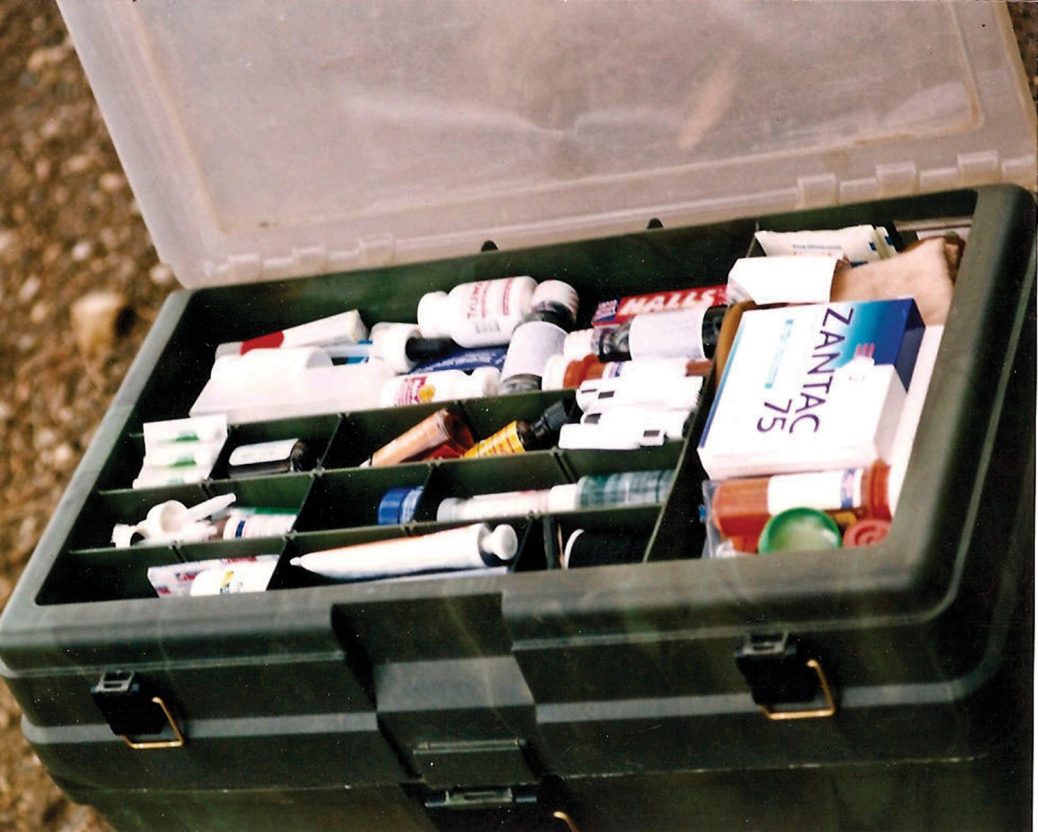
Very good article, Jackie. I have a question on dehydrated foods. Recently I dried carrots, celery, onions and bananas. I am storing them in canning jars. Approximately how long should they last? Thank you.